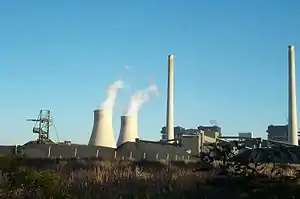Bayswater Power Station
Bayswater Power Station is a bituminous (black) coal-powered thermal power station with four 660 megawatts (890,000 hp) Tokyo Shibaura Electric (Japan) steam driven turbo alternators for a combined capacity of 2,640 megawatts (3,540,000 hp). Commissioned between 1985 and 1986, the station is located 16 kilometres (10 mi) from Muswellbrook, and 28 km (17 mi) from Singleton in the Hunter Region of New South Wales, Australia.
| Bayswater Power Station | |
|---|---|
 Bayswater Power Station with coal | |

| |
| Country | Australia |
| Location | Hunter Region, New South Wales |
| Coordinates | 32°23′45″S 150°56′57″E |
| Status | Operational |
| Commission date | 1985–1986 |
| Owner(s) | AGL Energy |
| Thermal power station | |
| Primary fuel | Coal |
| Turbine technology | Steam turbine |
| Cooling source | Hunter River |
| Power generation | |
| Units operational | 4 × 660 megawatts (890,000 hp) |
| Make and model | Tokyo Shibaura Electric (Japan) |
| Nameplate capacity | 2,640 MW |
| Annual net output | 17,000 GW·h (estimated) |
| External links | |
| Website | www |
| Commons | Related media on Commons |

Prior to September 2014 Bayswater Power Station was part of NSW Government power producer, Macquarie Generation.[1] Macquarie Generation was acquired by AGL Energy in September 2014.[2]
History
The first generator was completed in 1985, and the remaining three generators progressively that same year and throughout 1986.
Bayswater draws its cooling water from the Hunter River under water entitlements negotiated with the government of New South Wales. The Barnard River Scheme also allows Bayswater and Liddell to transfer water from the upper Manning River catchment into the Hunter River for their use. Much of the coal is supplied by overland conveyors from mines it shares with the nearby Liddell Power Station.
Coal consumption is around 8 megatonnes (8,800,000 short tons) per annum and produces around 17,000 gigawatt-hours (61,000 TJ) of electricity a year. This is enough power for 2 million average Australian homes and families.
Greenhouse emissions
Carbon Monitoring for Action estimates this power station emits 19.80 million tonnes of greenhouse gases each year as a result of burning coal.[3] In 2010 the Australian Government announced the introduction of a Carbon Pollution Reduction Scheme to help combat climate change. It is expected to impact on emissions from power stations. The National Pollutant Inventory provides details of a range of pollutant emissions, including CO, estimated at 1,600,000 kilograms (3,500,000 lb) for the year ending 30 June 2011.[4]
In 2009, the power station was the subject of "the first ever legal action aimed at curbing greenhouse gas pollution from a coal-fired power station". Environmental activist Pete Gray went to the Land and Environment Court of New South Wales, asking it to find that the power station had been "wilfully or negligently disposing of waste [...] by emitting carbon dioxide into the atmosphere in a manner that has harmed or is likely to harm the environment in contravention of section 115(1) of the Protection of the Environment Operations Act 1997", and sought an injunction against the station. The case, Gray and Anor v Macquarie Generation, was ongoing at the time of Gray's death from cancer in April 2011.[5][6][7][8]
Mid-life upgrade
In December 2018, a proposed upgrade to the Bayswater Power Station was approved to be completed around the same time as the proposed closure of the Liddell Power Station in 2022. Both are owned by AGL Energy and consume coal from the same mine. The upgrade approval did not impose tighter air emission controls, however AGL claimed that the closure of Liddell would result in a net improvement in air quality. The upgrade will increase the rated capacity of three turbines on the four generating units, increasing the capacity of each unit by 25MW whilst slightly decreasing the amount of coal consumed.[9]
Plant information
Boilers
- Steam pressure: 16,550 kilopascals (2,400 psi)
- Steam temperature: 540 °C (1,004 °F)
- Height: 80 metres (260 ft)
Turbo alternators
- Number in use: 4
- Manufacturer: Tokyo Shibaura Electric Company, (Toshiba) Limited, Japan.
- Operating speed 3,000 rpm
- Alternator voltage: 23 kV
- Rating: 660 megawatts (890,000 hp)
- Length: 50 metres (160 ft)
- Weight: 1,342 metric tons (1,479 short tons)
Turbine house
- Length: 510 metres (1,670 ft)
- Height: 38 metres (125 ft)
- Width: 40 metres (130 ft)
Emission stacks
- Height: 248 metres (814 ft)
- Diameter at base: 23 metres (75 ft)
- Diameter at top: 12 metres (39 ft)
Cooling towers
- Height: 132 metres (433 ft)
- Diameter at base: 100 metres (330 ft)
- Diameter at top: 52 metres (171 ft)
References
- "Macgen Website"
- "AGL completes acquisition of Macquarie Generation assets", 2 September 2014
- "Plant overview: Bayswater". Carbon Monitoring for Action. 2007. Retrieved 23 November 2008.
- "Bayswater Power Station, Muswellbrook NSW". National Pollutant Inventory. Commonwealth of Australia: Department of Sustainability, Environment, Water,m Population and Communities. 30 March 2012. Retrieved 7 June 2012.
- O'Neill, Margot (27 July 2009). "Greenhouse gas laws disputed in court" (transcript). Lateline. Australia: ABC TV. Retrieved 9 June 2012.
- Vincent, Julien (2 May 2011). "Remembering Pete Gray". Greenpeace Australia Pacific. Retrieved 9 June 2012.
- Gray v Macquarie Generation [2010] NSWLEC 34
- Cubby, Ben (28 July 2009). "Power firm sued over carbon emissions". The Sydney Morning Herald. Retrieved 9 June 2012.
- McCarthy, Joanne (8 December 2018). "Upper Hunter air quality will improve 'significantly' after Liddell closes, says Bayswater upgrade report". The Newcastle Herald. Retrieved 8 December 2018.
External links
- Macquarie Generation page on Bayswater